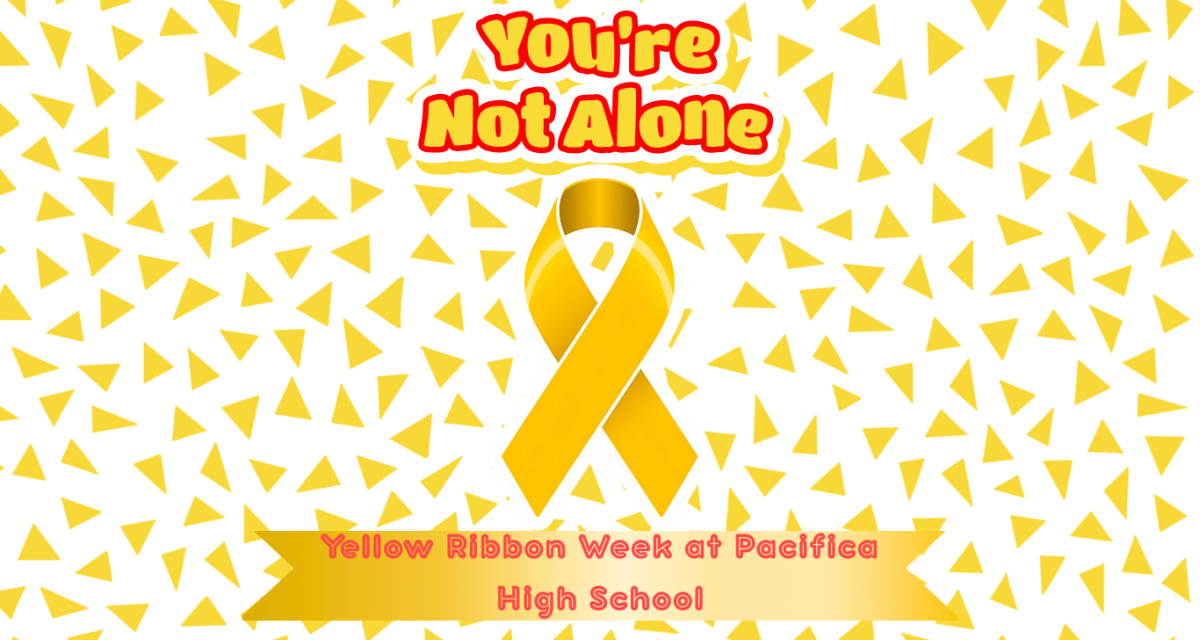
The Yellow Ribbon Suicide Prevention Program was founded in 1994 following the tragic death of 17-year-old, Mike Emme, by suicide. In response, his family and friends created the program to raise awareness, offer support, and ensure that no one ever feels so alone that ending one’s life seems like the only option. According to the Yellow Ribbon organization, the movement later inspired Yellow Ribbon Week, which is recognized during the week of World Suicide Prevention Day on September 9. The color yellow was chosen in honor of Mike’s bright yellow 1968 Ford Mustang—one of his most cherished possessions. Today, the yellow ribbon stands as a powerful symbol of hope, help, and remembrance.
At Pacifica High School, our goal is to be as supportive as possible and ensure that anyone can seek help when they need it. Here’s what our Yellow Ribbon Week looked like:
Monday, September 8th — “Brighten Up Someone’s Day!”
Students wore bright colors and at lunch a poster was available for students to write down what makes their day better. This poster was then placed prominently on the cafeteria windows for all to see.
Tuesday, September 9th — “Kindness Ties Us Together!”
Participants wore neck ties to school to represent how kindness “connects” us all.
Wednesday, September 10th — “Wave Goodbye to Stress!”
Students were asked to dress in tropical attire, and at lunch there were a few performances by Unified song/dance, including one from choir, to encourage relaxation, reduce anxiety, and remind students to take time for their mental well-being.
Thursday, September 11th — “Block Out the Negativity!”
Everyone rocked sunglasses for a fun and lighthearted spirit day focused on “blocking out” negative thoughts.
Friday, September 12th — “Plant Love, Kindness, & Acceptance”
The week ended with an impactful message that many students took part in by wearing yellow and having the chance to get their face painted at lunch.
This week was extremely important, and yes, while all the dress up days and activities brought energy and fun to the campus, it was ultimately about something deeper—a chance to remind students here at Pacifica that support is always within reach. If someone is struggling with suicidal thoughts or just having a hard time, there are people ready to listen and help. The school counselors, school psychologists, school social workers, and our mental wellness advocates on campus play a large role in promoting a safe and caring environment filled with compassion and understanding throughout the entire school.
To provide a clearer picture of the mental health support available on campus, Mrs. Anahi, one of our school’s mental health specialists, explained, “We offer one-on-one counseling and group sessions, and can also pop into classrooms to do SEL (Social-Emotional Learning) lessons.” Excitingly, she also mentioned that students will soon be able to access mental health resources during tutorial periods. To get the student perspective on Yellow Ribbon Week, ASB Sophomore Class President Tatum Girba shared, “I hope that students will take away from Yellow Ribbon Week that suicide is a very real issue, even among high schoolers.” She also added that spirit week “is a simple and easy way to spread awareness that makes it easier to talk about this important topic.” By sharing these perspectives, it’s clear that we play an important part in helping spark meaningful conversations and reinforcing the message that no one at Pacifica has to face their struggles alone.
Ultimately, mental health should be a daily priority, not just something we talk about once a year. It’s up to all of us: students, teachers, and staff to build a culture where people feel safe to speak up and know they’re supported. Whether it’s checking in on a friend who seems down, reaching out when things get tough, or simply showing kindness in everyday moments, these small actions can make a big difference. Our school offers dependable, trusted adults ready to listen and comfort you through whatever challenges you’re facing. Yellow Ribbon Week may be over, but that doesn’t mean the conversation should end. Let’s carry its message forward, to uplift, to care, and to always be there when someone needs a shoulder to lean on. Together, we can create a community where every student feels seen, heard, and valued.